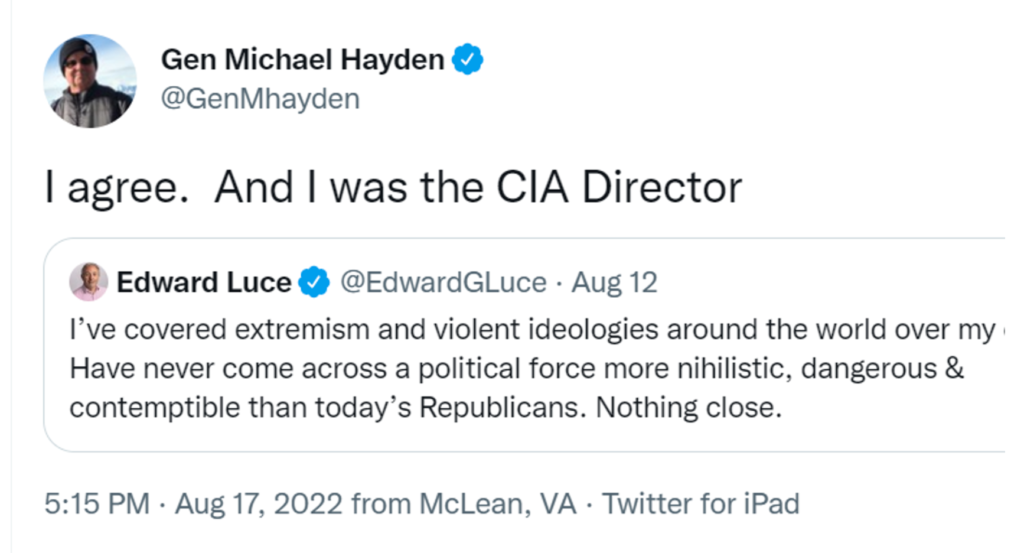‘Live Not By Lies’
Civil War 2.0? Not On Techno-Totalitarians’ Watch
US is running parallel to outbreak of Spanish Civil War, but our Regime has something the Socialists of the 1930s did not: technological supremacy

Good morning from England, where I’m at a conference. Yesterday, an Albanian immigrant taxi driver, upon finding out that I and a friend sharing the cab with me are American, asked us if he’s right that America seems to be headed towards civil war. We said probably not, but it is certainly true that we are extremely polarized, and there seems to be no good way out of this impasse.
Well, here at the conference I’ve just met Prof. Nathan Pinkoski, an American academic who wrote an excellent essay last year in Claremont Review of Books, on the subject of the Spanish Civil War. It’s worth revisiting in light of our current moment. From the essay:
The Second Spanish Republic (1931–1939) suffered one of the most accelerated cases of democratic decline in European history. In 1931, Spain established a liberal, republican, democratic constitution on a wide basis of popular and elite support. In just a few years, the constitution was in ruins and Spain was at war with itself. How did this happen? Too often, Americans are taught a simpleminded morality tale about this period: the fascists destroyed democracy. But the true story of Spain’s troubled republic is much more interesting and instructive. It shows how democratic regimes can die from self-inflicted wounds.
Pinkoski bases his essay on the scholarship of Stanley Payne, who is the leading history of the Spanish Civil War writing in English. More:
In Civil War in Europe, 1905–1949 (2011), Payne examines Spain in light of Europe’s cycle of revolutionary civil wars that made the first half of the 20th century so violent. Most civil wars before the 20th century concerned either succession—conflicts between potential heirs—or secession—such as the American Civil War. In the 20th century a new, revolutionary kind of civil war arose in Europe, pitting irreconcilable conceptions of state, society, and culture against each other. In these conflicts, revolutionaries and counterrevolutionaries aimed to establish radically different regimes. Payne is fond of quoting Joseph de Maistre’s dictum: “the counterrevolution is not the opposite of a revolution, but is an opposing revolution.” Once the revolutionary process begins, the old regime is finished. Both revolutionaries and counterrevolutionaries—who are ostensibly interested in restoring the status quo ante—must found a new regime. As Carl Schmitt observes in Ex Captivitate Salus (1950), the determination of both sides to establish a new regime is the reason why revolutionary civil wars bring unprecedented levels of violence. The goal is to overturn the whole legal and political order associated with the enemy, leading to the call for the enemy’s absolute elimination.
This is massively important. The Spanish Civil War was not about rivals within a system; it was about the system itself. This is why matters are so irreconcilable in the United States today. The Left has been captured by a revolutionary ideology that will not tolerate rivals at all, and in fact construes tolerance for dissent as an unacceptable compromise with evil. It is pushing the forces of the Right towards radicalization and illiberalism simply for the sake of self-preservation.
More:
Though a variety of parties helped set the revolution going, Payne argues that the chief culprits were the Spanish socialists. Unlike Bolsheviks, who seek to overthrow liberal constitutionalism by direct means, revolutionary socialists use the constitutional system to provide cover for their plan to dismantle it. They don’t overthrow the legal system, they exploit it. Legalists of the center and the Right struggle to respond to this tactic. In Spain, their failure was particularly acute. In The Collapse of the Spanish Republic, 1933–1936 (2005) and The Spanish Civil War (2012), Payne describes Spain’s descent into a brutal three-year war as the result of the socialist Left’s brazenness meeting the center’s carelessness and the Right’s pusillanimity.
Other European socialist movements began with revolutionary ambitions but mellowed as they grew older and came to respect constitutionalism and parliamentary norms. Over time, Spanish socialists became more radical. The most important leftist leader in Spain, Manuel Azaña (prime minister from 1931 to 1933 and again in 1936), contended that liberalism failed because it was too willing to compromise. He regarded the republican constitution as the beginning of a radical reform project—even calling it a “revolution.” Politicians who didn’t equate constitutionalism with leftism were ipso facto illegitimate.
To Spanish socialists, the Right—which failed to save the monarchy in the 1920s and never articulated a different constitutional basis for the new republic—was a spent force. They were therefore shocked at the result of the 1933 election, when a seemingly stable left-wing coalition collapsed and the Right unexpectedly won. Assured that history was on their side, but now convinced that it needed a strong nudge to stay on course, the motivation of leftists became, in Payne’s assessment, a “visceral” desire to stay in power: “One way or the other, they were planning to hold onto it.”
Our contemporary American Left are not revolutionaries in the classical sense. They have marched through the institutions, and are exploiting the system to effectively overthrow it. And today, when you see the people in the Regime collaborating to delegitimize populism in all its forms, think of the Spanish socialists. More:
Second, the center and center-Left enabled the descent into revolutionary politics by winking at the Left’s violence and punishing the Right’s. The rise of the “anti-fascist” trope in the 1930s, recounted in Paul Gottfried’s excellent Antifascism: The Course of a Crusade (2021)—which Payne himself has recently praised in an essay for First Things—served to stain anyone who disagreed with the Left. In Spain, it excused the violence of young socialists. Centrist authorities were unable or unwilling to stop attacks on private property, businesses, churches, convents, and clergy. Instead, they blamed the victims, arresting not the actual perpetrators but scapegoating monarchists and conservatives. As cultural theorist René Girard understood, this scapegoating does not break the cycle of violence, but intensifies it. When revolutionaries attempt to purify a corrupt state and society through scapegoating, those whom they kill become martyrs, whose sacrifice becomes redemptive for nascent counterrevolutionaries. In Spain, scapegoating monarchists and conservatives converted large sections of the population from apathy to anger. By letting murders go unpunished and unjustly punishing innocents, the Left created martyrs throughout Spain—galvanizing the counterrevolution and turning the conflict into a religious war.
Think of the different response the Regime had to the “mostly peaceful” riots of the Summer of Floyd, versus the January 6 attack. This is NOT to justify January 6, or to minimize its badness. It is rather to say that both violent events were treated very differently by the Regime and its media component. Similarly, today, the Department of Justice’s attorney in Boston put out a statement vowing to protect doctors and hospitals that sexually mutilate children from violence. Fine. But think of all the pro-life crisis pregnancy centers that have been hit with violence by the Left since the overturning of Roe vs. Wade. The Regime — both progressives and center-rightists — are creating a kind of martyr.
One more Pinkoski quote:
The third factor in the collapse of the republic was the centrist endorsement of unconstitutional action in the name of saving the so-called liberal consensus—what French political theorist Pierre Manent has called “the fanaticism of the center.”
This brought to mind the shocking tweet last week from Gen. Michael Hayden, once America’s top spy:

From Gen. Hayden’s Wikipedia page:
He was Director of the National Security Agency (NSA) from 1999 to 2005. During his tenure as director, he oversaw the controversial NSA surveillance of technological communications between persons in the United States and alleged foreign terrorist groups, which resulted in the NSA warrantless surveillance controversy.
So you know who Gen. Hayden is, and what he is prepared to do to his fellow Americans to protect the Regime. Here is a passage from my book Live Not By Lies that tells you what we are dealing with:
In 2013, Edward Snowden, the renegade National Security Agency analyst, revealed that the US federal government’s spying was vastly greater than previously known. In his 2019 memoir, Permanent Record, Snowden writes of learning that
the US government was developing the capacity of an eternal law-enforcement agency. At any time, the government could dig through the past communications of anyone it wanted to victimize in search of a crime (and everybody’s communications contain evidence of something). At any point, for all perpetuity, any new administration—any future rogue head of the NSA—could just show up to work and, as easily as flicking a switch, instantly track everybody with a phone or a computer, know who they were, where they were, what they were doing with whom, and what they had ever done in the past.
Snowden writes about a public speech that the Central Intelligence Agency’s chief technology officer, Gus Hunt, gave to a tech group in 2013 that caused barely a ripple. Only the Huffington Post covered it. In the speech, Hunt said, “It is really very nearly within our grasp to be able to compute on all human-generated information.” He added that after the CIA masters capturing that data, it intends to develop the capability of saving and analyzing it.
Understand what this means: your private digital life belongs to the State, and always will. For the time being, we have laws and practices that prevent the government from using that information against individuals, unless it suspects they are involved in terrorism, criminal activity, or espionage. But over and over dissidents told me that the law is not a reliable refuge: if the government is determined to take you out, it will manufacture a crime from the data it has captured, or otherwise deploy it to destroy your reputation.
Subscribe Today
Get weekly emails in your inbox
This, I think, is why any talk of an American civil war is mostly just talk. The Regime — meaning both the State and private institutional actors — have the technological power to marginalize those it wants to marginalize. When we become a cashless society — and the Regime used Covid as an opportunity to move us all towards that goal (remember the “coin shortage” bullshit?) — it will be impossible to buy and sell if your card is disabled electronically. That’s simply true.
I was talking with a couple of academics this morning about all of this, and we agreed that in a very short time, when the captive minds of the Millennials and Generation Z achieve political dominance, there will be a widespread agreement that these measures should be taken against the deplorable dissidents. We Americans today have created a system that can be used against us to crush our liberties — and a progressive totalitarian-therapeutic culture that will insist on it for our own good.
What do we do about it? What can we do about it, and what must we do about it? We had better start talking about it among ourselves, and innovating, and networking — while we still can. In a sense, lurid speculation about “civil war” prevents us from talking more seriously about threats to our liberties from this emerging revolutionary bourgeois Regime, and how we can realistically resist it.

